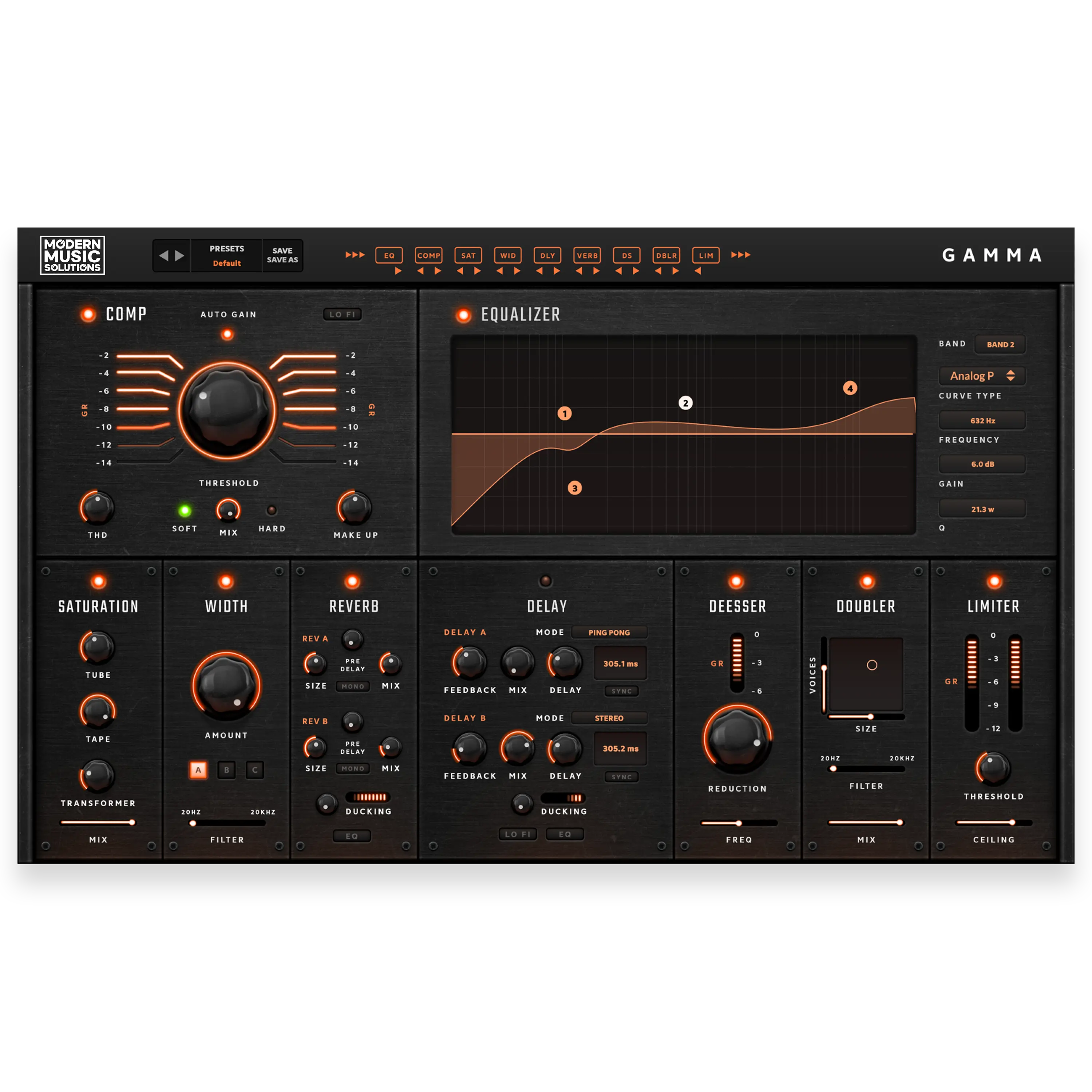Guitar riffs are the backbone of rock and metal music. They define the character and intensity of a song, leaving a lasting impression on listeners. Whether you're a beginner or an experienced guitarist, honing your riff-writing skills can take your compositions to the next level. In this article, we'll explore five quick tips to help you write better guitar riffs that will jumpstart your entire songwriting process!
Tip 1: Experiment with Different Tunings
One way to breathe fresh life into your riff writing is by experimenting with different guitar tunings. While standard tuning (EADGBE) is commonly used, alternative tunings offer unique possibilities for creating innovative and distinct guitar riffs. By deviating from traditional tuning, you can unlock new chord voicings, melodic patterns, and tonal textures that can inspire your creativity.
Quick note: Don't worry, you don't have to go out and get your guitar set up every time you want to try a different tuning. Using a pitching function, such as the built-in pitch shifter in Clairvoyant, to achieve different tunings can work great for songwriting and experimentation.
Popular tunings in rock and metal music
Several tunings have become staples for modern metal, and in the past 10 years, we've seen bands dropping their guitars tunings lower, and lower.
Here are a few popular examples:
- Drop D (DADGBE): This popular tuning allows for powerful low-end riffs and makes it easier to play crushing power chords with one finger barring across the bottom strings.
- Drop C (CGCFAD): Frequently used in heavier genres, Drop C tuning provides a deep, menacing sound that is ideal for chugging riffs and intricate lead lines.
- Drop G (GCGCFAD): Adding a seventh string to your guitar opens up new sonic possibilities. Drop G tuning delivers an even lower tone, perfect for creating hard hitting riffs and djent-style grooves.
- Drop E (EBEADGBE): A popular option for 8-string guitars, Drop E puts the guitar into the same register as the bass tuning. This creates a massive and aggressive sound, allowing you to create exceptionally heavy riffs with extended range and power.

Benefits and challenges of working with different tunings
Experimenting with alternative tunings has several benefits. It can spark creativity, inspire new musical ideas, and help you develop a unique sonic identity. However, it's important to note that working with different tunings also presents challenges. Learning the new fingerings, adapting to different string tensions, and transposing familiar chord shapes can require time and practice.
Remember to approach alternative tunings with an open mind and embrace the learning process. The exploration itself can lead to unexpected musical discoveries and fuel your writing endeavors.
Tip 2: Combine Techniques and Styles
To create dynamic and engaging guitar riffs, it's essential to merge various techniques and styles. By combining different elements, you can develop a unique signature sound and stand out from the crowd. Experimenting with diverse techniques and styles allows you to explore a wide range of musical possibilities and add depth to your riff writing.
Examples of techniques and styles
In modern metal, there are numerous techniques and styles that you can draw inspiration from. Here are a few examples:
- Alternate Picking: Alternate picking involves using a combination of downstrokes and upstrokes to play notes. This technique adds speed and precision to your riffs, allowing for rapid-fire sequences and intricate patterns.
- Tapping: Made famous by guitar virtuosos like Eddie Van Halen and Tim Henson (Polyphia), tapping involves using the fingers of your picking hand to tap notes on the fretboard. Incorporating tapping into your riffs can create complex, and enjoyable textures to your track.
- Palm Muting: Palm muting is one of the most famous techniques, and it is where you lightly rest the edge of your picking hand near the bridge to dampen the strings. This technique adds a percussive and aggressive quality to your riffs, commonly found in heavy genres such as metalcore, deathcore and djent.

Blending techniques and styles
When crafting guitar riffs, don't limit yourself to one technique or style. Experiment with blending different techniques and styles to create a unique sonic palette. For example, you can combine alternate picking with palm-muted power chords for a fast and heavy riff, or incorporate tapping into melodic arpeggios to add a touch of virtuosity.
Remember, the key is to find a balance between the techniques and styles you choose. Think about how guys like Tim Henson, Jason Richardson, and Tosin Abasi consistently create new sounds that people didn't even know could be created on a guitar!
Let your creativity guide you as you explore different combinations, and don't be afraid to break the rules to achieve the sound you envision.
Tip 3: Utilize Power Chords and Palm Muting
When it comes to modern metal, power chords and palm muting are essential tools for creating heavy and aggressive guitar riffs. Power chords, consisting of the root note and the fifth, provide a strong and punchy sound that forms the backbone of many iconic riffs.
Most heavy bands use drop tunings and this is to make power chords easier to play. Palm muting, on the other hand, adds a percussive and controlled quality by dampening the strings with the edge of your picking hand.
Incorporating power chords and palm muting effectively
Here are some tips for utilizing power chords and palm muting in your riff writing:
- Rhythmic Variation: Experiment with different rhythmic patterns using power chords and palm muting. Vary the duration of each chord and the length of the muted sections to create a dynamic and engaging rhythm.
- Accentuation: Use palm muting to accentuate certain notes within a riff. By selectively releasing the muting for specific chord hits or single-note lines, you can create a sense of tension and build anticipation.
- Chord Inversions: Explore different inversions of power chords on the fretboard. Moving the root note to a different string or incorporating additional notes can add complexity and richness to your riffs.
- Combining with Open Strings: Experiment with integrating open strings alongside power chords and palm muting. This technique can create interesting melodic interplay and harmonic depth within your riffs.

Variations and embellishments
While power chords and palm muting are effective on their own, don't be afraid to incorporate variations and embellishments to add flavor to your riffs. Experiment with octave doubling, sliding power chords, or incorporating additional notes within the power chord shape to create unique and memorable passages.
By mastering the art of power chords and palm muting and exploring their various possibilities, you'll be able to craft powerful and aggressive guitar riffs that command attention.
Tip 4: Focus on Rhythm and Syncopation
Rhythm plays a vital role in creating memorable guitar riffs. It sets the groove, establishes the feel of the song, and can make your riffs stand out from the rest. Syncopation, in particular, adds a sense of unpredictability and rhythmic tension by accenting off-beat notes or emphasizing unexpected subdivisions. Modern metal is often defined by the grooves and intricate patterns within the songs.
Improving rhythm for riff writing
Here are some suggestions to enhance your rhythmic abilities for riff writing:
- Practice with a Metronome: Develop a solid sense of timing by practicing with a metronome. Start by playing simple rhythmic patterns and gradually increase the tempo. Focus on playing precisely on the beat and gradually incorporate syncopated accents.
- Explore Different Subdivisions: Experiment with different subdivisions within a measure. Break away from the standard quarter notes and explore eighth notes, triplets, or sixteenth notes to add rhythmic variety and interest to your riffs.
- Use Rests and Silence: Don't underestimate the power of silence in your riffs. Incorporate intentional rests to create pauses and emphasize certain accents. The strategic use of silence can enhance the overall impact and dynamics of your riff. Think about how bands often use silence to intensify the anticipation of a big breakdown.
- Study Rhythmic Patterns in Songs: Analyze and study the rhythmic patterns in songs you admire. Pay attention to how the guitar interacts with the drums and other instruments. Incorporate similar rhythmic ideas into your own riff writing while adding your unique touch.

Exercises for improving rhythm
To further enhance your rhythmic abilities, consider practicing the following exercises:
- Accent Shifting: Take a simple riff or melodic pattern and experiment with shifting accents to different beats or subdivisions. This exercise helps you develop a keen sense of rhythmic manipulation and creativity.
- Rhythmic Layering: Layer different rhythmic patterns together by playing multiple parts simultaneously. Start with two simple patterns and gradually add complexity. This exercise improves your coordination and rhythmic dexterity.
Remember, rhythm is the heartbeat of your guitar riffs. By honing your rhythmic skills and incorporating syncopation, you'll create riffs that groove, captivate, and leave a lasting impression on your listeners.
Tip 5: Experiment with Effects and Textures
Adding effects and textures to your guitar riffs can elevate them to new heights and create a unique sonic landscape. Effects pedals and digital plugins offer a wide range of possibilities, allowing you to sculpt your tone and add depth and atmosphere to your riffs.
Popular Effects for Modern Metal
Here are some popular effects to consider incorporating into your riff writing:
- Distortion/Overdrive: Distortion and overdrive pedals provide the crunch and grit necessary for heavy guitar riffs. Experiment with different levels of gain to find the right balance between clarity and aggressiveness. Sometimes, less gain makes for heavier tones because of the clarity.
- Delay: Delay effects create echoes and repeats of your guitar signal, adding a spacious and atmospheric quality to your riffs. Use it to enhance melodic lines or create rhythmic patterns that cascade and evolve over time.
- Reverb: Reverb simulates the natural ambience of different spaces, ranging from subtle room reflections to expansive cathedral-like reverberations. Applying reverb to your riffs can make them sound larger-than-life and immersive.
- Modulation (Chorus, Flanger, Phaser): Modulation effects add movement and dimension to your guitar tone. Chorus provides a shimmering and thickening effect, flanger produces a sweeping and jet-like sound, while phaser creates a swirling and dynamic texture.
Layering and experimentation
Don't be afraid to experiment with layering different effects and textures to create unique sounds. Combine distortion with delay for a soaring lead riff, or add modulation effects to a palm-muted power chord progression for a hypnotic and swirling effect.
Recording and production considerations
When recording your riffs, pay attention to the production aspects as well. Experiment with panning, stereo imaging, and EQ to ensure that your guitar sits well in the mix and retains clarity and impact. Remember, the goal is to enhance your riffs and create an immersive sonic experience. By exploring effects and textures, you can transform your guitar riffs into sonic masterpieces that showcase your creativity and leave a lasting impression on your listeners.
Conclusion
In conclusion, writing better guitar riffs for rock and metal music requires a combination of experimentation, technique, and creativity. By following these five quick tips—experimenting with different tunings, combining techniques and styles, utilizing power chords and palm muting, focusing on rhythm and syncopation, and exploring effects and textures—you'll have some of the fundamentals used by modern metal guitarists.
Remember to join our free Facebook Group created by us at Modern Metal Songwriter! It's a place where you can connect with other musicians, share your work, and gain valuable insights and inspiration from the community. We have many active songwriters in there available to offer helpful criticism and advice if you need it!
Thanks for reading, and Happy Songwriting!









